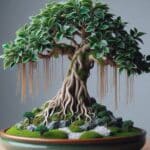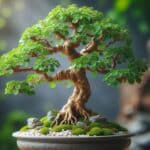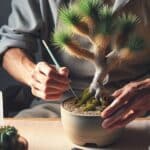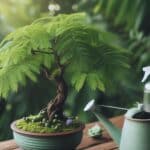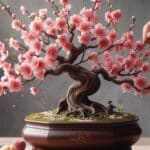Need a helping hand in your bonsai cultivation efforts? You should consider the Japanese Red Maple bonsai.
The Japanese maple tree has a scientific name of Acer palmatum. It is aptly named, as the five-lobed leaves of this plant look just like a hand – and “palma ” is the Latin word for the palm of your hand.
A gorgeous plant, the Japanese Red Maple is easy to cultivate as a bonsai specimen.
Interesting Facts about Japanese Maple Bonsai
- Height: 40” maximum
- Width: 10 inches
- Sunlight: Partial shade in warm climates
- Flowering Time Length: May to June
- Lifespan: can be up to 100 years or more
- Scientific name: Acer Palmatum
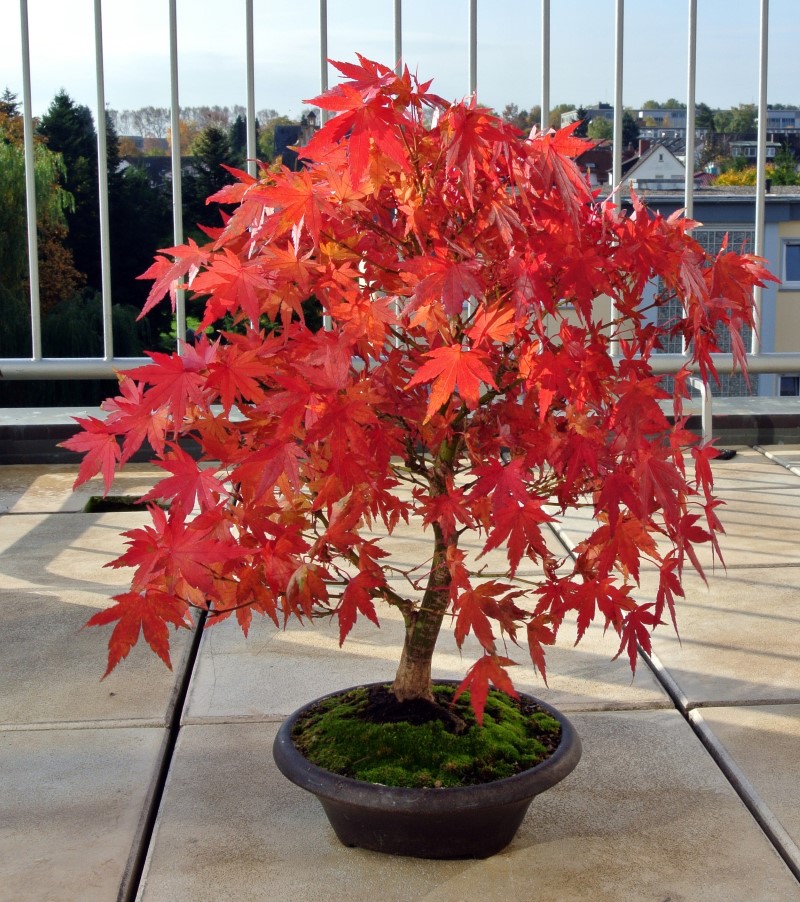
Types of Acer Palmatum
The Japanese Maple is well-known for its lovely appearance. There are multiple cultivars available, most of which produce unique leaf colors and shapes and grow to various sizes. These plants are popular not only as bonsai specimens, but also as ornamental shrubs.
Some of the most popular types of Japanese Red Maple, most of which can be grown as bonsai plants, include:
- Deshojo
- Arakawa
- Seigen
- Kashima
- Shishigashira
No matter which type you choose, you’ll enjoy gorgeous leaves that produce green-yellow flowers in clusters around Mayor June. The bark of a young tree is usually a red or green color that fades to a pale grey or brown as the tree ages.
Most Japanese Maple trees produce lovely autumn foliage. This can be yellow or orange, but in the Japanese Red Maple bonsai, as you might expect from the name alone, that foliage is red.
Growing Japanese Red Maple Bonsai from Seed or By Propagation
Japanese Red Maple bonsai trees can be grown from seeds or cuttings. Ideally, it should be propagated (regardless of the method) in early summer. You can use air-layering to propagate a Japanese Red Maple or you can purchase it as a starter plant from a nursery.
If you are going to plant from seeds, you will want to place the seeds in the refrigerator for 100 days. This will allow stratification to occur, which breaks down the tough seed coating and prepares the seeds for germination. Then, let the seeds soak for at least 24 hours before planting. You can plant in a heat-proof container.
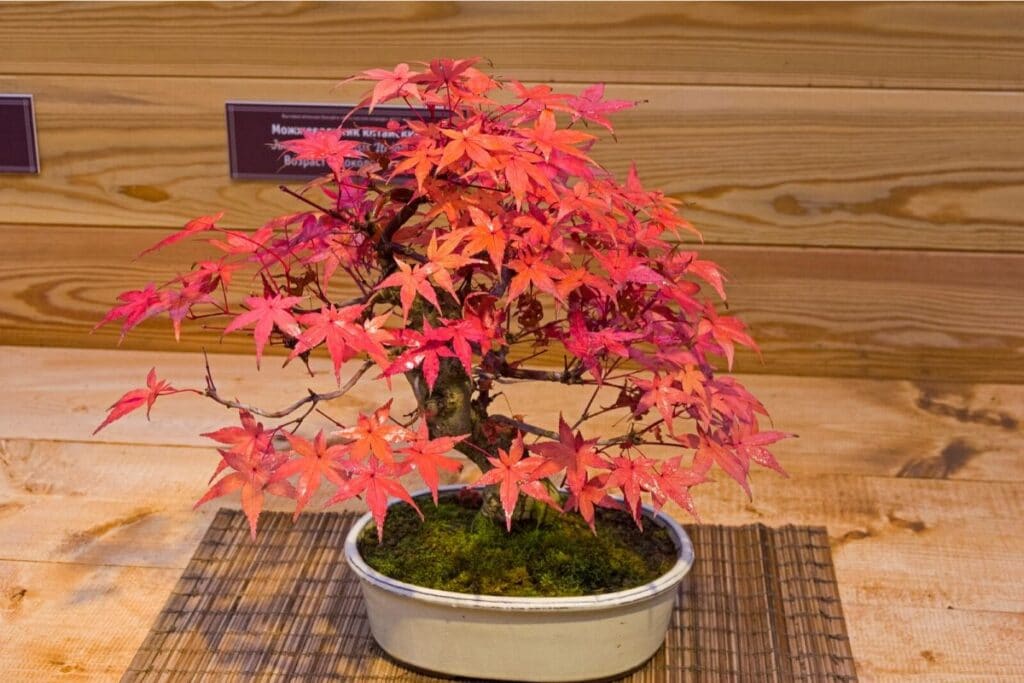
How To Care For Japanese Maple Bonsai
Here are the growing conditions for Japanese maples. Keep this in mind when selecting Japanese maple companion plants.
Sunlight
Plant your Dwarf Japanese Maple bonsai where it can receive light shade during the intense midday heat. This frost-hardy plant can be grown in most locations, but should be protected from a strong frost and conditions below 14 degrees Fahrenheit whenever possible.
Otherwise, any sunny, well-aerated location should do. Light shade will protect the delicate leaves of the plant during hot weather.
Watering
Most Japanese Maple cultivars need to be watered often, particularly during the hottest days of the growing season. While you can get away with once-a-day or every other day watering during cooler periods, during the hottest times, it will need daily or twice daily watering.
To produce a healthy, vigorous growing tree, you will want to use water that does not contain lime or other alkaline ingredients. It prefers conditions that are neutral or even slightly acidic.
Fertilizing
You should fertilize your Japanese Red Maple bonsai about once a week to encourage strong growth. Otherwise, follow the dosage instructions on your fertilizer, because this plant can get away with less frequent watering, too.
Use a solid organic fertilizer for best results. These kinds of fertilizer will release slowly and gently into the soil rather than providing a strong burst of nutrients all at once.
Try to avoid fertilizers with lots of nitrogen and instead opt for a well-balanced blend. Too much nitrogen can cause explosive leaf development at the expense of the leaves.
Potting and Repotting
You can repot your Japanese Red Maple bonsai every other year. When you repot your bonsai plant, try to prune the roots. This plant is known for putting out strong roots, and you’ll find that your bonsai pots quickly becomes filled with vigorously-growing roots that can overwhelm the small space.
It’s crucial to carefully assess the root system to ensure its health and vitality. Gently remove the tree from its current pot and examine the roots, trimming away any dead or damaged roots with sharp, clean scissors or pruning shears.
You should use a well-draining soil mixture that is specifically formulated for Japanese Red Maple and other bonsai. A bonsai soil mixed with lava rock or pumice will be best for this kind of plant.
Pruning a Japanese Maple Bonsai
You should prune your Japanese Red Maple bonsai on a regular basis, several times per year. Unlike many other bonsai specimens, it can be pruned year-round. You should trim back twigs and shoots.
If you are going to be pruning stronger, more sound branches, you should do this in the fall. This can prevent bleeding, which often happens when you plant in the spring or summer (or any other time when growth occurs rapidly).
When you prune, simply cut new growth back to a single or double pair of leaves. Keep the twigs thin. You can also remove these oft tips of shoots that grow between the initial pairs of leaves.
You may remove leaves every other year, ideally in the early summer, which will encourage the growth of small leaves. To do this, remove all leaves but leave the leaf-stems intact. Be gentle while doing this. Alternatively, you can remove only large or closely spaced leaves, too. This can be done every year, as it’s not quite as stressful as full-leaf pruning.
Pests and Diseases
Unfortunately, Japanese Red Maple bonsai is prone to some fungal diseases, like verticillium wilt. These most commonly enter the plant via wounds. This fungal disease can partially or fully kill your Japanese Red Maple bonsai.
To prevent this, try to avoid pruning your plant during high-risk periods of intense growth, like the dead of summer. You should also use a cut paste when pruning, which can reduce the likelihood of fungal growth.
When it comes to pests, you’ll need to watch out for aphids. These can be removed with vigilant manual inspection and removal. You can also use insecticides, but you’ll want to be careful about applying these too often.
Where to Buy Maple Bonsai
Japanese red maple bonsai and other Japanese bonsai trees can be purchased from just about any online nursery. It is usually shipped as a starter plant around two or three years old. You can also purchase seeds, which are sold in batches of 20-50 apiece.
FAQ
How do you keep a Japanese maple bonsai small?
To keep a Japanese maple bonsai small, regularly prune its branches and roots to control its size and shape. Additionally, maintain proper watering and fertilizing practices, and choose an appropriately sized container to restrict its growth. Lastly, provide the tree with the right light conditions and temperature to ensure its compact form.
How do you fix root rot on Japanese maple?
To fix root rot on a Japanese maple, you should carefully remove the tree from its pot, trim away the affected roots, and let the remaining healthy roots dry out for a day. Repot the tree in well-draining soil and adjust your watering habits to prevent future overwatering, which can cause root rot. Ensure the tree receives proper air circulation and sunlight to aid in its recovery.
Can a Japanese maple be an indoor bonsai?
Yes, Japanese maples can be grown as indoor bonsai, but they require specific care. To succeed, provide them with adequate light, temperature, and humidity levels, and consider periodic outdoor exposure to ensure their overall health and well-being.
*Photo by possum/depositphotos


